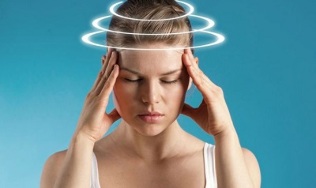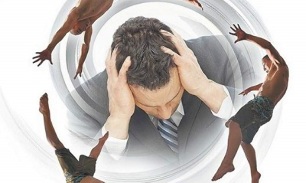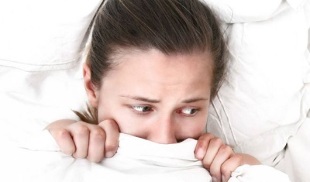
Spine conditions often cause completely undesirable symptoms.
At first glance, they have nothing to do with this disease. But - a person with cervical osteonecrosis, and dizziness, fear and depression can easily become a part of his life as well.
For a successful treatment, it is important to correctly identify the root cause of these problems.
Dizziness from bone necrosis: causes of it
A fibroid of the cervix is especially dangerous because it interrupts the blood supply to the brain. Deformation of the disc and vertebrae can compress the vertebral artery, which supplies up to a quarter of the blood needed by the brain.
Dizziness is a direct result of oxygen starvation in the brain. In the milder stages of the disease, the disease usually occurs intermittently and for a short time. The head may feel dizzy after sleeping or when there is a sudden change in body position. If the disease progresses, this can last for hours. Often it is also accompanied by nausea, vomiting, and impaired vision.
It is very important to determine the correct cause of the problem. The head may experience dizziness not only from bone necrosis. Similar symptoms can be attributed to disorders of the heart and blood vessels, anemia and other diseases. In this case, the treatments have to be completely different. Often times, misdiagnosis forces people to treat high blood pressure for many years or other similar conditions instead of treating the spine.
Blood pressure and cervical bone necrosis
In this case, cervical bone necrosis can also cause manifestations of vegetative vascular dystonia. The cause also lies in the pinched vertebrae, as well as muscle spasm. Intracranial pressure reacts particularly painfully with osteonecrosis.

This phenomenon can manifest as headache, feeling of heaviness, tinnitus, impaired vision. The use of conventional medications to treat high blood pressure has no results (or they are short-lived). Again, the correct diagnosis is the key to treatment success.
Increased pressure can also be painful, so the manifestations of VSD in osteonecrosis can be very strong.
If, in addition to the neck, chest area is also affected, interrupted heart activity, arrhythmia, and a feeling of chest tightness can be observed. Again, the heart medication was not working.
Osteochondrosis is very dangerous because it gives symptoms similar to those of other serious diseases. Lots of causes could be attributed to him, and you could miss out on urgent need for heart and blood vessel emergency help.
What to do if you feel dizzy with cervical bone necrosis
If undiagnosed, vertigo from bone necrosis can be suspected if it occurs during a change in position. Also, the neck is often cracked.
Dizziness can be eliminated by maintaining normal blood circulation in the neck. You can try self-massage as an effective quick remedy. To prevent relapses, you will need to go through a course of treatment. What to do in specific cases, the doctor will advise.
Different drugs and therapies may be required at different stages of the disease:
- A muscle relaxant therapy that relaxes muscle spasms.
- B vitamins - they also have a beneficial effect on blood circulation.
- Several professional massages, followed by regular neck massages.
- Physical therapy is a must - movements release the pinched vessels and stimulate blood flow.
Long exposure to fresh air works well. You should stop smoking and limit alcohol consumption, as these bad habits negatively affect blood circulation. And it's important to make a timely diagnosis of fibroids, and dizziness, fear, and depression won't have time to develop.
Reasonable and unfounded fear of osteonecrosis
Osteochondrosis manifests not only physically, but also psychologically. Usually, this disease is accompanied by panic attacks and obsessive fear.

Their appearance has objective and subjective reasons. Unjustified panic can be the result of a stroke.
But more frequent fear is the consequences of other painful manifestations of osteonecrosis:
- Patient is constantly waiting for the pain and fearing them.
- There is a fear of being disabled.
- Scary duration of treatment with the prospect of no results.
- Some of the symptoms are predictive of other diseases (heart attack, stroke, stomach pain).
Such psychological reactions can only be avoided with appropriate attitudes. Patients need to constantly remind themselves that osteonecrosis is not a sentence. Don't skip pain relievers so you don't fear pain. The patient's relatives and acquaintances must continually demonstrate confidence in his ability to recover quickly and maintain a constructive attitude.
Depression can be the result of osteonecrosis
If such "psychotherapy" is not done, there is a risk of depression.
This can have many unpleasant consequences:
- Loss of performance, chronic fatigue syndrome.
- Insomnia.
- Mental impairment.
- A serious violation of self-esteem.
- Menstrual irregularities in women.
- Gastrointestinal disturbances.
- Numbness in some parts of the body.
Depression on the run can even lead to suicidal intentions, so ignoring its manifestations is dangerous.
Depression occurs as a response to prolonged pain and discomfort. Its occurrence is also motivated by social problems inevitably accompanying patients with osteonecrosis.
- Feeling a loss of opportunity for a fulfilling life.
- "Drop out" lasts after working.
- Be aware that illness causes inconvenience to loved ones.
- Feeling helpless, trying in vain - the disease does not go away even after taking measures.
It is important to keep in mind that some painkillers also have a depressive effect on the central nervous system and can lead to a state of depression. So you cannot overdo strong pain relievers, just use them for exacerbations. If there is no severe pain, it is better to use ointments, massage and physiotherapy procedures. Relatives of the patient should be aware that depression often prevents the patient from realizing their problem, so they will most likely have to "push" him toward treatment.
Treatment of psychological problems in osteonecrosis
In the case of severe depression with many dangerous manifestations, strong antidepressants are often required. But you need to know that all such drugs have an addictive effect, and you cannot use them for long. As soon as the most severe manifestations are eliminated, such drugs should be discarded.
To get rid of fear and depression, it is necessary first of all to self-treat bone necrosis. A set of standard measures are suitable for this: removal of muscle spasms, chondroprotectors for strengthening cartilage tissue, physical education, physical therapy. But at the same time it is necessary to improve the mental state of the patient.
- Regular walking and moderate physical activity are required. Light physical activity stimulates pleasure.
- To normalize sleep, you need an orthopedic pillow or just a low, stiff pillow. The bedroom must always be well ventilated.
- Others should encourage patient recovery.
- It is important to involve the patient in common life, housework and public service as possible. In most cases, you can find activities that don't hurt your spine. But that person will find it helpful and necessary.
- In severe cases, the help of a psychiatrist and even a psychiatrist may be needed. There's no need to be afraid - seeing a psychiatrist doesn't mean you're out of your mind.
The main thing is "call to order" cervical bone destruction, and dizziness, fear and depression will no longer be threatening. In the context of a reduction in painful manifestations, psychological recovery will be much better.
But the best thing to do is avoid these symptoms. Treatment of cervical necrosis should be initiated promptly, and dizziness, fear and depression will never appear.







































